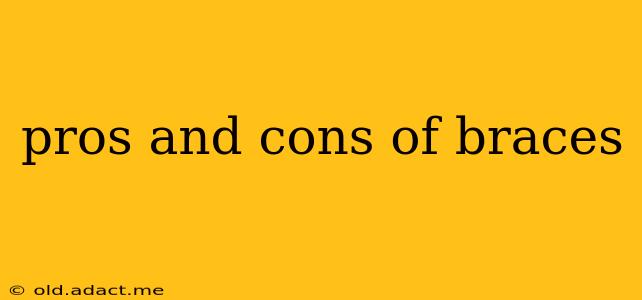Orthodontic treatment with braces is a significant decision, impacting both your oral health and your appearance. Weighing the pros and cons carefully is crucial before embarking on this journey. This comprehensive guide will explore the advantages and disadvantages of braces, answering common questions and helping you make an informed choice.
Pros of Braces: Straight Teeth and a Healthy Smile
The primary benefit of braces is undoubtedly the improvement in the aesthetics of your smile. Straight teeth are generally considered more attractive, boosting self-confidence and improving self-esteem. However, the advantages extend far beyond just cosmetic appeal.
Improved Oral Hygiene
Straight teeth are easier to clean. Crowded or misaligned teeth create spaces and crevices where food particles and plaque can accumulate, leading to cavities, gum disease (gingivitis and periodontitis), and even tooth loss. Braces help align teeth, making brushing and flossing significantly more effective. This results in improved oral hygiene and a reduced risk of dental problems.
Enhanced Bite and Chewing Function
Malocclusion, or a bad bite, can make chewing difficult and lead to jaw pain, headaches, and temporomandibular joint (TMJ) disorders. Braces correct bite problems by aligning your jaws and teeth, improving chewing efficiency and reducing the strain on your jaw muscles. This can alleviate chronic pain and discomfort.
Long-Term Oral Health
By correcting bite issues and improving oral hygiene, braces contribute to long-term oral health. Preventing tooth decay and gum disease through proper alignment can save you from costly dental procedures and potential tooth loss in the future. This makes braces a worthwhile investment in your long-term oral well-being.
Improved Speech (in some cases)
In some cases, misaligned teeth can affect speech clarity. Braces can help improve pronunciation by correcting the position of teeth involved in speech production.
Cons of Braces: Challenges and Considerations
While the benefits of braces are considerable, it's important to acknowledge the potential drawbacks.
Discomfort and Pain
The initial placement of braces and subsequent adjustments can cause discomfort and some pain. While this discomfort is usually manageable with over-the-counter pain relievers, it's a factor to consider. Soreness and irritation of the gums and cheeks are also common.
Dietary Restrictions
Certain foods are off-limits while wearing braces. Hard, crunchy, or sticky foods can damage the brackets or wires, requiring repairs or adjustments. This means temporarily saying goodbye to popcorn, hard candies, and caramel.
Length of Treatment
Orthodontic treatment can take several months or even years, depending on the complexity of the case. The extended duration requires patience and commitment to regular appointments and home care.
Cost of Treatment
Braces can be expensive, and the cost varies depending on the complexity of the case, the type of braces used, and your insurance coverage. Explore financing options and insurance benefits before starting treatment.
Potential for Complications
While rare, complications can arise during treatment. These can include broken brackets, loose wires, mouth sores, or allergic reactions to the materials used in braces. Regular check-ups with your orthodontist are crucial for early detection and management of any complications.
Frequently Asked Questions about Braces
Here are some frequently asked questions about braces, often found in the "People Also Ask" section of search results:
How long does it take to get braces off?
The length of treatment varies greatly depending on the individual's case and the complexity of the misalignment. Treatment typically lasts 18-30 months, but can be shorter or longer.
How much do braces cost?
The cost of braces varies significantly based on location, orthodontist, type of braces (metal, ceramic, Invisalign), and insurance coverage. It's best to consult with multiple orthodontists for personalized quotes.
What are the different types of braces?
Several types of braces exist, including traditional metal braces, ceramic braces (aesthetically pleasing), and Invisalign (clear aligners). Each has its pros and cons in terms of cost, appearance, and effectiveness.
Are braces painful?
While some initial discomfort and soreness is common after placement and adjustments, most individuals find the pain manageable with over-the-counter pain relievers.
Can adults get braces?
Absolutely! Adults can and do get braces. Orthodontic treatment is not limited to children or adolescents. The success rate of treatment is largely unaffected by age.
What are the long-term effects of braces?
The long-term effects of braces are overwhelmingly positive. Improved oral health, a straighter and healthier smile, and reduced risk of dental problems are the most common benefits.
By carefully considering the pros and cons and addressing your specific questions, you can make a well-informed decision about whether braces are the right choice for you. Remember to consult with a qualified orthodontist for a personalized assessment and treatment plan.
